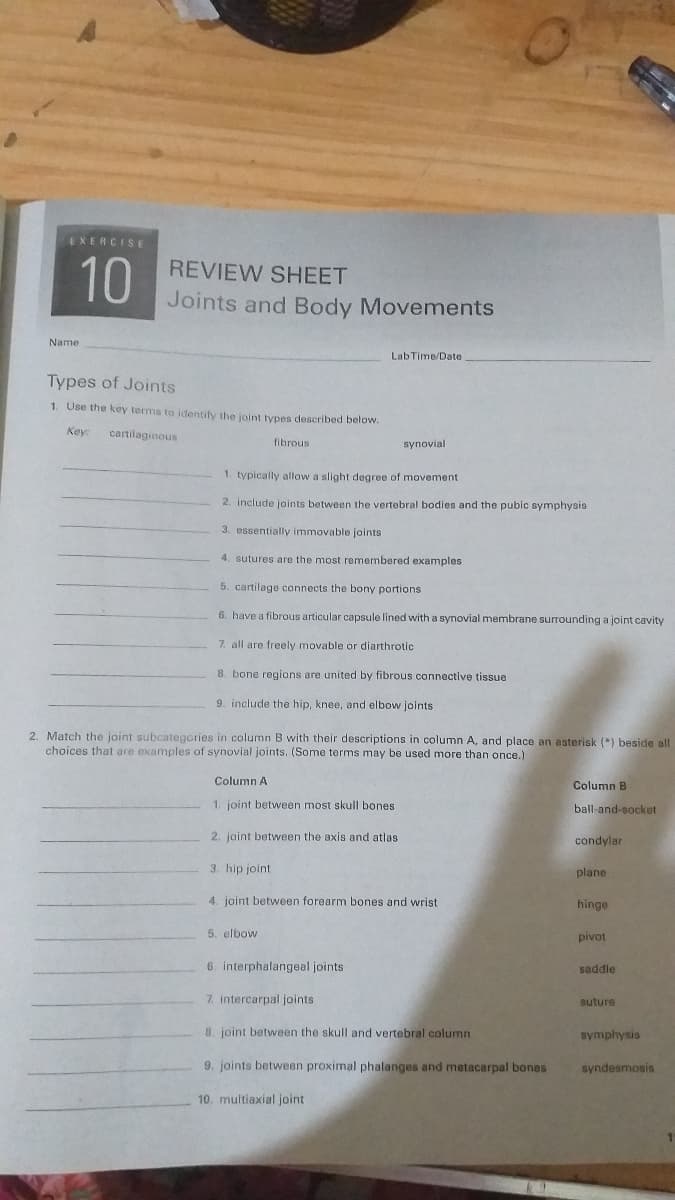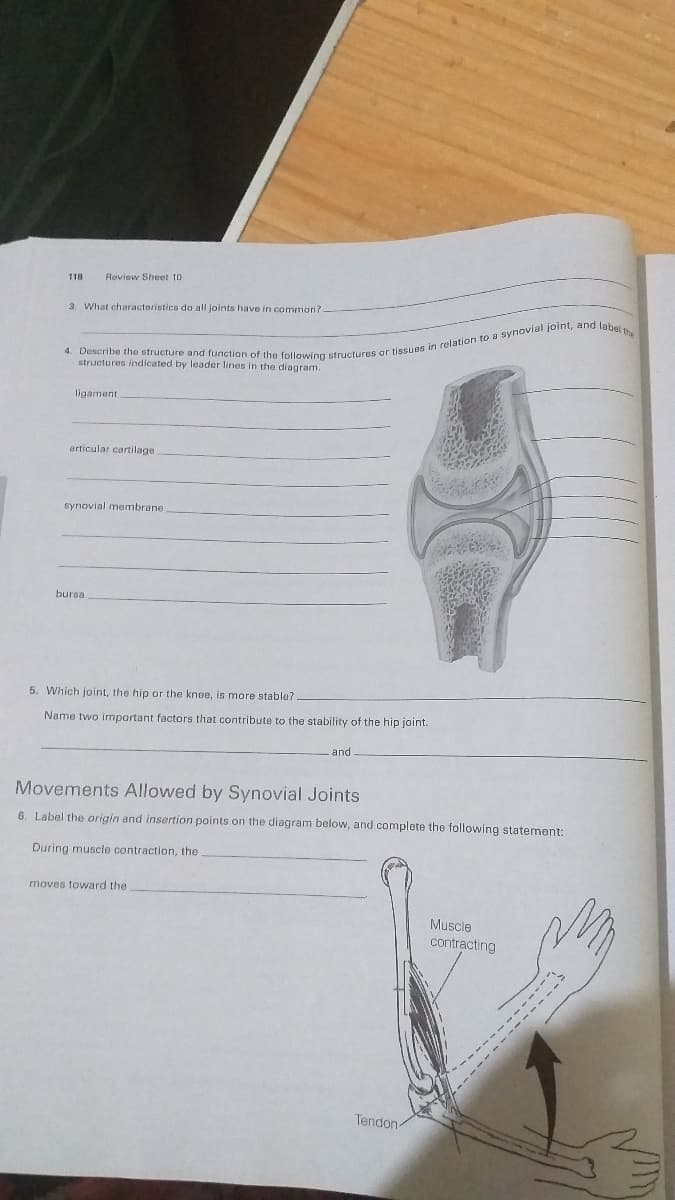1. Use the key terms to identity the joint types described below. Key: cartilaginous fibrous synovial 1. typically allow a slight degree of movement 2. include joints between the vertebral bodies and the pubic symphysis 3. essentially immovable joints 4. sutures are the most remembered examples 5. cartilage connects the bony portions 6. have a fibrous articular capsule lined with a synovial membrane surrounding a joint cavity 7. all are freely movable or diarthrotic 8. bone regions are united by fibrous connective tissue 9. include the hip, knee, and elbow joints
1. Use the key terms to identity the joint types described below. Key: cartilaginous fibrous synovial 1. typically allow a slight degree of movement 2. include joints between the vertebral bodies and the pubic symphysis 3. essentially immovable joints 4. sutures are the most remembered examples 5. cartilage connects the bony portions 6. have a fibrous articular capsule lined with a synovial membrane surrounding a joint cavity 7. all are freely movable or diarthrotic 8. bone regions are united by fibrous connective tissue 9. include the hip, knee, and elbow joints
Human Anatomy & Physiology (11th Edition)
11th Edition
ISBN:9780134580999
Author:Elaine N. Marieb, Katja N. Hoehn
Publisher:Elaine N. Marieb, Katja N. Hoehn
Chapter1: The Human Body: An Orientation
Section: Chapter Questions
Problem 1RQ: The correct sequence of levels forming the structural hierarchy is A. (a) organ, organ system,...
Related questions
Question

Transcribed Image Text:EXERCISE
10
REVIEW SHEET
Joints and Body Movements
Name
Lab Time/Date
Types of Joints
1. Use the key terms to identify the joint types described below.
Key:
cartilaginous
fibrous
synovial
1. typically allow a slight degree of movement
2. include joints between the vertebral bodies and the pubic symphysis
3. essentially immovable joints
4. sutures are the most remembered examples
5. cartilage connects the bony portions
6. have a fibrous articular capsule lined with a synovial membrane surrounding a joint cavity
7. all are freely movable or diarthrotic
8. bone regions are united by fibrous connective tissue
9. include the hip, knee, and elbow joints
2. Match the joint subcategories in column B with their descriptions in column A, and place an asterisk (*) beside all
choices that are examples of synovial joints. (Some terms may be used more than once.)
Column A
Column B
1. joint between most skull bones
ball-and-socket
2. joint between the axis and atlas
condylar
3. hip joint
plane
4. joint between forearm bones and wrist
hinge
5. elbow
pivot
6. interphalangeal joints
saddle
7. intercarpal joints
suture
8. joint between the skull and vertebral column
symphysis
9. joints between proximal phalanges and metacarpal bones
syndesmosis
10. multiaxial joint

Transcribed Image Text:118
Review Sheet 10
3. What characteristics do all joints have in common?.
structures indicated by leader lines in the diagram.
ligament
articular cartilage
synovial membrane
bursa
5. Which joint, the hip or the knee, is more stable?
Name two important factors that contribute to the stability of the hip joint.
and
Movements Allowed by Synovial Joints
6. Label the origin and insertion points on the diagram below, and complete the following statement:
During muscle contraction, the
moves toward the
Muşcle
contracting
----
Tendon
------ -----
Expert Solution
This question has been solved!
Explore an expertly crafted, step-by-step solution for a thorough understanding of key concepts.
This is a popular solution!
Trending now
This is a popular solution!
Step by step
Solved in 2 steps

Recommended textbooks for you

Human Anatomy & Physiology (11th Edition)
Anatomy and Physiology
ISBN:
9780134580999
Author:
Elaine N. Marieb, Katja N. Hoehn
Publisher:
PEARSON

Anatomy & Physiology
Anatomy and Physiology
ISBN:
9781259398629
Author:
McKinley, Michael P., O'loughlin, Valerie Dean, Bidle, Theresa Stouter
Publisher:
Mcgraw Hill Education,

Human Anatomy
Anatomy and Physiology
ISBN:
9780135168059
Author:
Marieb, Elaine Nicpon, Brady, Patricia, Mallatt, Jon
Publisher:
Pearson Education, Inc.,

Human Anatomy & Physiology (11th Edition)
Anatomy and Physiology
ISBN:
9780134580999
Author:
Elaine N. Marieb, Katja N. Hoehn
Publisher:
PEARSON

Anatomy & Physiology
Anatomy and Physiology
ISBN:
9781259398629
Author:
McKinley, Michael P., O'loughlin, Valerie Dean, Bidle, Theresa Stouter
Publisher:
Mcgraw Hill Education,

Human Anatomy
Anatomy and Physiology
ISBN:
9780135168059
Author:
Marieb, Elaine Nicpon, Brady, Patricia, Mallatt, Jon
Publisher:
Pearson Education, Inc.,

Anatomy & Physiology: An Integrative Approach
Anatomy and Physiology
ISBN:
9780078024283
Author:
Michael McKinley Dr., Valerie O'Loughlin, Theresa Bidle
Publisher:
McGraw-Hill Education

Human Anatomy & Physiology (Marieb, Human Anatomy…
Anatomy and Physiology
ISBN:
9780321927040
Author:
Elaine N. Marieb, Katja Hoehn
Publisher:
PEARSON